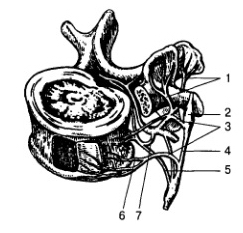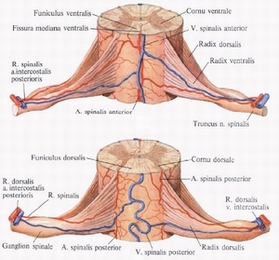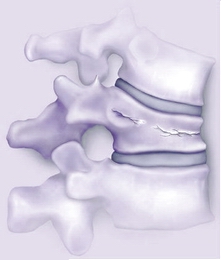The normal structure of the spine:
- spine has a wave shape (cervical lordosis, thoracic kyphosis, lumbar lordosis and kyphosis sacrococcygeal)
- curvature of the spine in the correct posture provide uniform pressure surfaces vertebral discs, with the disc is squeezed flat and does not seek to shift
- the motion vector of the spinal disc compressing force is changing, but once stabilized by the return to the center position with good posture
- In spite of the large number of component parts of the spine acts as a single body, it should be considered as a whole
 |
 |
 |
Vertebra and around:
despite what they say in most of the bones and cartilage (vertebrae and disks), to take into account all other important structures which, when compression or inflammation cause all of the clinical manifestations of diseases of the spine:

Blood supply of the spinal column and each vertebra separately includes both arterial network and an extensive network of veins and venous plexus that pass including right through the bone
The innervation of the vertebra:
 |
 |
Nerve system of Lyushka (by A.A.Otelin)
- back branch spinalis nerve and its branches to the spines
- branches from the sympathetic ganglion to the transverse process
- branches of the sympathetic trunk to the body of the vertebrae
- sympathetic trunk
- sympathetic root to the meningeal branch
- plexus root of the vessels to the meningeal branch
- meningeal branch
 |
Spinal cord membranes, which pass to the roots and go with them to foraminary holes between the transverse processes of the vertebrae:
|
|
Vertebral arteries of the cervical spine are in the holes of the transverse processes of the cervical vertebrae and supply blood to the brain stem Spinal ligaments, which forms the spine and connects all the pieces together: |
 |
Joints and joints of the spine, which provide flexibility in the spine, vertebra is joint-disc-vertebra, which are provided by cartilaginous
surfaces of the vertebral discs and faceted (arc-otroschatymi) joints, which form the upper and lower articular processes of the vertebrae,


is even more complex articular joints at the top of the cervical spine between the occipital bone, and the first and second cervical vertebra


in the thoracic spine and joints are added to the point of attachment to the spine 12 pairs of ribs (two on each edge)


The main causes of problems:
the main reason is a violation of spine flexibility and elasticity of his ligaments, which lead to a breach of the optimum geometry of the spine, abnormal load distribution and the development of the pathological process of (only lists the most common causes)
- inherent non-optimal shape of the spine
- postural defects formed throughout life, especially in children, scoliosis, asymmetry legs and pelvis, etc.
- spinal injuries, especially undetected and untreated in destkom age, which is often found
- occupational injuries associated with prolonged forced position
- rheumatic complications of inflammatory diseases
- age-related changes in bone and cartilage, and the elasticity and flexibility
- lack of optimal physical activity
Changes in posture and compression spinal injury:

The mechanism of bask pain:
non-optimal load elements spine leads to microtrauma and tissue development as a consequence of local aseptic inflammation, then the organism getting painful primary impulse, forms protect the affected places with muscle spasm of the surrounding muscles, the victim usually with significantly reduced range of motion, which in turn increases local swelling. As a result, developing compression (compression) of soft tissue, which is the next factor in the further development of microtrauma, the entire chain of events described above is further enhanced ... Then join neuro symptoms associated with the constant irritation of the nerves, autonomic-vascular symptoms associated with circulatory disturbance (including for example the brain), and then degenerative changes of the intervertebral disc, facet joints, etc., etc. At a young age, and with a sufficient amount of traffic, this process can be stopped in a few weeks to stabilize, and in middle and old age without rational therapy is the development of the spine in this scenario to end.
In addition it should be understood that the defeat of one segment will inevitably lead to a change of geometry (posture) and the load in the rest of the spine. Therefore, the disease often progresses gradually captures other parts of the spine.
Leading element of pathology: changing geometry relations and optimal load on the components of the spine, the development of tissue microtrauma due to compression and subsequent inflammation.
Normal principles of conservative therapy in modern polyclinic (ie 99% of patients):
Limited exposure, or even stay in bed, wearing a lumbar corset, analgesics and non-steroidal anti-inflammatory drugs (diclofenac, ortofen, Movalis), muscle relaxants (sirdalud, midokalm), antihistamines, diuretics to relieve swelling, vitamins - Milgamma etc. If this helps - paravertebral blockade or epidural blockade. In doing so, procaine (or lidocaine) will add a steroid medication to relieve swelling.
After blunting the pain for 2-3 weeks (without removing compression, without restoring the geometry and mobility, without restoring the optimal load distribution in the apparatus of the spine) rest pain is treated with analgesics, and the patient will recommend physical therapy, massage and physiotherapy. In this case, unfortunately, gymnastics will not be directed to the desired individual situation, and gymnastics will be "general". Therapist will help a bit, but without a stable remission. Physical therapy will accelerate local blood flow, but without restoring biomechanics may even increase the painful symptoms (frequent phenomenon).
As a result - if the compensatory potential of the body is large - the clinical manifestations will decrease over time. The body will find a way to adapt and a damaged disc, and a displacement of the joints, and under the initial treatment. If nothing is done, in many cases, after 3-4 weeks, the pain subsided. But this balance is precarious - heavy lifting, prolonged exposure to the legs or forced posture, emotional stress, fatigue, hypothermia, infection, failure to move and so on, will result in the aggravation of more and more often. Finally, after several years of torture will be offered surgery as By that time inevitably develop defeat disc.
Any treatment without restoring the correct geometry and optimum power relations spine is more than paleativnym. It solves the problem of partial analgesia and often, unfortunately, leads to all the sad result.
What to do?
- first well to be examined in order to understand the amount of assistance available and to determine the possible serious hazards or lack thereof (compression of nerve trunks, disc protrusion, herniation with possible sequestration, kompremirovaniya roots and the meninges, spinal stenosis holes and cerebrospinal canal, etc. .)
- not hope for help miraculous "protivoradikulitnyh" ointments and creams to use analgesics for pain relief in the acute stage, but understand that these drugs provide temporary relief of pain, but fundamentally solve nothing
- find a good specialist in manual medicine and osteopathy better with experience on the spine to restore mobility and the right balance of tissues
- provide themselves with the opportunity traction therapy to relieve compression damage and compensation, as well as for further treatment after the removal of symptoms of the acute period
- find the optimal physical therapy
- restore posture
- treated calmly and logically


